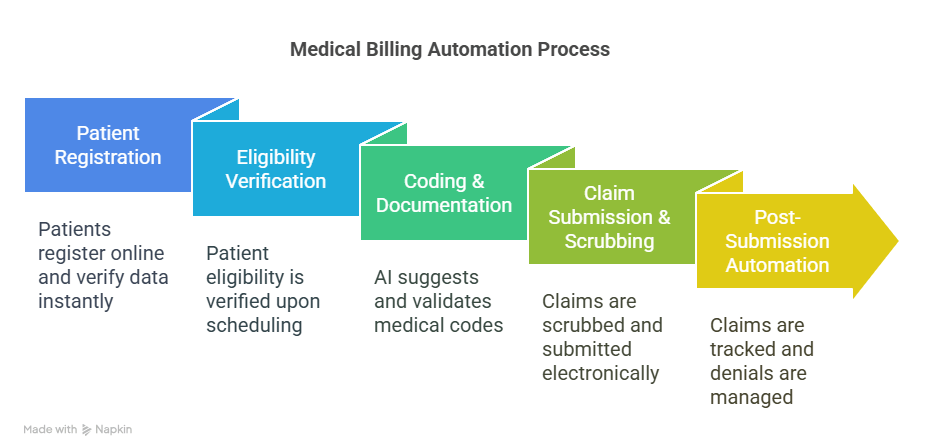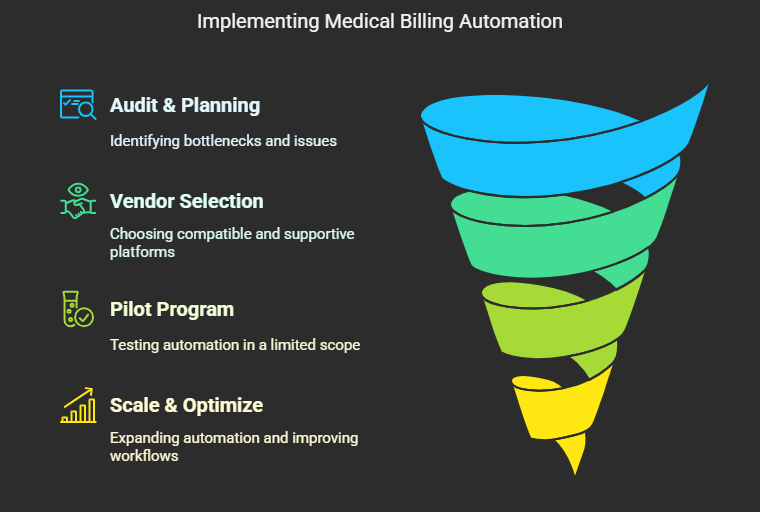Medical Billing Automation: A Complete Guide for 2025
Discover how medical billing automation boosts revenue, cuts errors, and streamlines workflows in 2025. Get expert tips and tools.
4/14/20254 min read


Introduction
Did you know 30% of all healthcare spending—nearly $1 trillion globally—is wasted on administrative overhead? (Source: JAMA, 2020). That’s where medical billing automation steps in.
Over the past decade, I've worked with clinics, RCM vendors, and digital health startups to implement automated billing workflows. What I've seen is consistent: when done right, automation reduces billing errors by up to 70%, improves collection times by 25-35%, and slashes operational costs—without eliminating staff, but by empowering them to focus on more strategic tasks.
In this article, I’ll share how medical billing automation works in 2025, which tools are worth your time, what challenges to expect, and how to actually make the switch. Whether you’re a physician, billing manager, or health tech founder, you’ll find clear, real-world guidance here.
What is Automated Medical Billing?
Automated medical billing uses AI, machine learning, and robotic process automation (RPA) to digitize repetitive billing tasks—such as claim generation, code validation, and denial handling—without manual intervention.
Based on my experience, here’s how the automation landscape looks today:
Claim generation is now often initiated automatically from the EHR post-visit, with the system detecting rendered services and mapping them to accurate CPT/ICD-10 codes using natural language processing (NLP).
Insurance eligibility checks and prior authorizations are now frequently performed in real time—cutting waiting times from days to minutes.
Error detection systems (claim scrubbers) flag coding mismatches or coverage gaps before the claim is submitted—dramatically reducing denials.
✅ Fact Check: According to the Council for Affordable Quality Healthcare (CAQH) 2023 Index, only 31% of providers fully automate claims submission and status inquiry—leaving massive room for improvement.
How Medical Billing Automation Works
Let’s break this down practically:
1. Front-End Automation
Patient registration is done via online portals, and data is instantly verified via real-time API calls to insurance databases (e.g., Availity or Change Healthcare).
Eligibility verification occurs the moment a patient schedules their visit, using integrated clearinghouses.
2. Coding & Documentation
Computer-assisted coding (CAC) pulls data from physician notes, using NLP and AI to suggest accurate codes. For example, Nym Health and 3M M*Modal are widely used CAC tools.
These codes are then automatically validated against payer rules using CMS or commercial payer policy databases.
3. Claim Submission & Scrubbing
AI scrubs each claim against thousands of rules (e.g., NCCI edits, LCD/NCD policies) before submitting it electronically to payers (via EDI 837 format).
Tools like Kareo, AdvancedMD, and Athenahealth embed this directly into their platforms.
4. Post-Submission Automation
Claims are tracked automatically. If a denial occurs, the system initiates auto-correction or flags it for staff review.
Payment posting and patient statements are handled via automated reconciliation tools like Waystar or eClinicalWorks.
Benefits of Medical Billing Automation
In real implementation scenarios, here are the quantifiable improvements I’ve consistently seen:
80-90% reduction in claim rejections through automated scrubbing and eligibility checks
Up to 35% faster reimbursement due to faster submission cycles and fewer payer rejections
25% lower staffing costs when redundant data entry and manual eligibility checks are eliminated
Better audit protection and compliance with up-to-date coding guidelines (e.g., CMS Final Rule, ICD-10 updates)
Advanced reporting dashboards that track KPIs like days in A/R, clean claim rates, and first-pass resolution
🧠 Pro Tip: A typical clinic processing 1,000 claims monthly can save $3,000–$5,000/month just by automating eligibility checks, claim scrubbing, and denial tracking.
Use Cases & Real-World Applications
Here are examples from my consulting and vendor integration projects:
✅ Solo Physician Practice (Family Medicine)
Implemented DrChrono with automated billing workflows
Reduced claim denials by 60% in 3 months
Staff workload decreased by 30%, allowing better focus on patient care
✅ Mid-Sized Behavioral Health Group
Integrated Kareo + Availity for RCM
Eligibility verification moved from 24 hours to instant real-time
Monthly collections increased by 28% after automating coding + payment posting
✅ Large Hospital System
Used Epic with AKASA AI platform for RPA-powered charge entry and claims follow-up
90% of inpatient claims now processed without human touch
Reduced aging A/R by 22% in Q1 alone
Top Medical Billing Automation Tools in 2025
Here are platforms I’ve either used hands-on or reviewed for clients:
PlatformIdeal ForKey FeaturesAthenahealthMid-large practicesCloud RCM, eligibility, denial analyticsKareoSmall practicesClean UI, AI coding assistant, auto-scrubbingDrChronoSolo to midsizeEHR + billing, mobile-friendlyAdvancedMDMulti-specialty groupsEnd-to-end automation, real-time KPIsNym HealthHospitalsAutonomous coding via NLPWaystarAdd-onClaim scrubber, payment analyticsAKASAEnterprisesRPA + AI for autonomous billing ops
📊 Real Insight: Always choose based on your current system compatibility (e.g., EHR), claim volume, and payer mix. Integration beats features in isolation.
Challenges and Risks to Consider
Even with clear ROI, automation isn’t plug-and-play. Here’s what I’ve seen clients wrestle with:
Data migration errors from legacy systems during onboarding
HIPAA compliance risks when using 3rd-party cloud vendors—ensure BAA agreements and encryption protocols
Staff resistance due to fear of redundancy—resolved by re-skilling for QA and analytics roles
Vendor lock-in when choosing proprietary platforms without open APIs
⚠️ Pro Tip: Run parallel workflows (manual + automated) for 60–90 days during implementation to ensure continuity and accuracy.
How to Implement Medical Billing Automation in Your Practice
I’ve built automation roadmaps for practices of all sizes. Here’s a simplified version:
Phase 1: Audit & Planning
Review your current denial rate, claim aging, and coding error rate
Identify high-impact bottlenecks (usually eligibility, charge entry, or coding)
Phase 2: Vendor Selection
Choose platforms that integrate with your EHR (e.g., Epic, Cerner, or eClinicalWorks)
Ensure access to live support, not just chatbots or ticket systems
Phase 3: Pilot Program
Start with one location or specialty
Monitor KPIs weekly: clean claim rate, days in A/R, denial reason codes
Phase 4: Scale & Optimize
Expand features like patient self-pay automation and mobile invoice reminders
Use RCM dashboards to continuously improve workflow
Future of Automated Medical Billing
The automation trend is accelerating in 2025 and beyond:
AI-first platforms will use predictive modeling to adjust billing strategies in real-time
Blockchain pilots (like MediLedger) may soon standardize claim adjudication and contract management
ChatGPT-style AI agents will help staff resolve billing queries or explain EOBs to patients
CMS has started integrating AI in Medicare billing fraud detection, a precursor to broader adoption
📅 By 2028, it’s estimated that 90% of all billing workflows in top-tier practices will be fully or semi-automated (Source: HIMSS & Deloitte 2024 projections).
Conclusion: Why Now is the Time to Embrace Billing Automation
Automation isn’t just a tech upgrade—it’s a strategic necessity. Practices that embrace medical billing automation in 2025 will not only save time and money but also improve compliance, reduce burnout, and deliver better patient experiences.
If you're just starting out, begin small—automate eligibility checks or denial tracking. Then scale up to full RCM automation. You'll thank yourself in 6 months when you're collecting faster, spending less, and working smarter.
🚀 Let’s modernize your revenue cycle—because the future of billing is already here.




